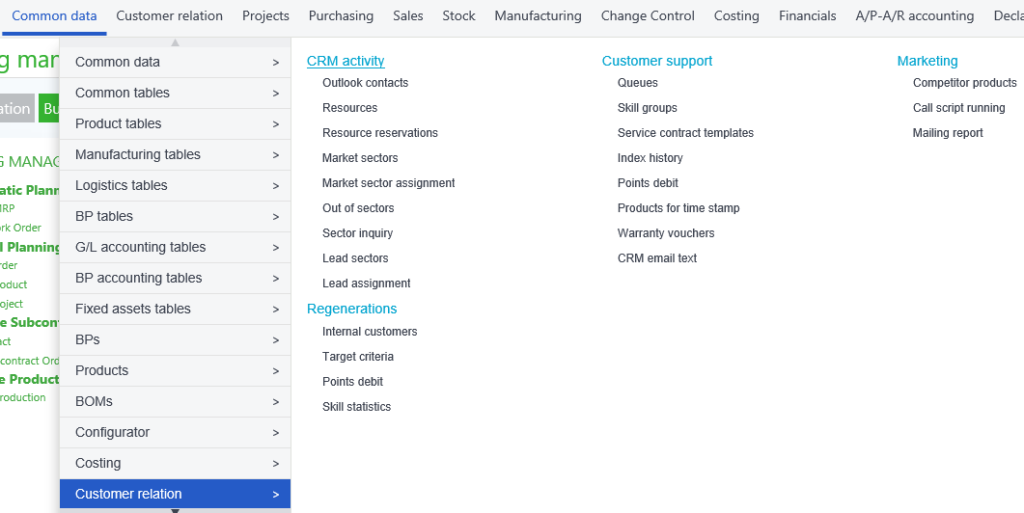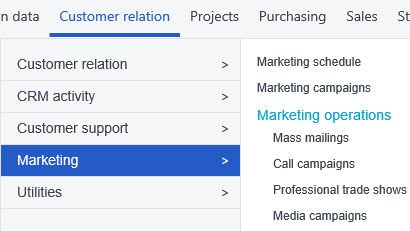
This is the fifth lesson in the series Learning Sage X3. In this lesson, we will cover the CRM features in Sage X3. Previous Sage X3 lessons: Important Acronyms and Definitions, General Navigation and User Interface, Sage X3 PU 11, Setting up Chart of Accounts.
The integrated functionality of the Sage CRM module is sometimes overlooked. Used in conjunction with the sales management function, this module allows the user to improve managing customer relations through marketing, campaigning, direct mailing, and post-sale maintenance.
Implement and Setup Sage X3 CRM
To implement and set up CRM, go to the Setup tab in the mega menu and select, “Customer Relation.” Here you can set up advanced targeting to locate/find potential customers. In addition, mass marketing, customer support, and more is available. This is the first step to setting up CRM in Sage X3.

Basic Functionality of Sage X3 CRM
In the Common Data tab, you can review the Customer Relation module offerings including CRM activity, customer support, marketing, and regeneration options.

As outlined in Joe Noll's blog CRM Features in Sage X3 You Might Not Know About, here are some of the major features Sage X3 CRM:
CRM for Sales – the sales portion of the CRM module allows you to schedule appointments, log inbound and outbound calls, schedule follow-up sales tasks, track customer and prospect communication, enter quotes, track hot sales opportunities, and more. Both pre- and post-sales steps can be set up in Sage X3 CRM so your entire process can be tracked from start to finish.
CRM for Marketing – create and launch mailing or phone campaigns and record activity at trade show events, your marketing department can track activities in progress and compare projected costs to campaign budget to measure the ROI of your marketing spend.
CRM for Customer Support – after the sale is made and a prospect becomes your customer, you can use Sage X3 CRM to track service contracts, maintenance agreements, and warranties. A service “workbench” allows you to view all requests in the queue, the status (in process or late), responses pending, and service employee work statistics.
Customer Relation Options
Finally, after setting up CRM, go to the Customer relation button in the mega menu at the top of Sage X3 to manage relationships with your customers.
Database
- SAGE X3 CRM contains a flexible database of business partners and contacts
- Relationships can be managed with existing customers or future BPs/prospects.
Sales Support
- Provides wide range of tools to manage customer relationships
- Presales actions: appointment scheduling, inbound and outbound phone call logs, assigning critical tasks, view customer/prospect activities.
Optional Module
- CRM is a fully integrated module within Sage X3, leveraging the same user interface, login and navigation workflow
- Results in significant time savings and increased efficiency.
Marketing Campaigns
- Compare projected costs to campaign budget
- Facilitate mailing/phone creation campaigns
- Record media and trade show events.
Customer Support:
- After sales customer management and tracking
- View service requests in “workbench” queue.
Reporting:
- Marketing, Sales, and Service reports
- Easily customizable.
A CRM Alternative
If you prefer, Sage X3 comes with an optional Salesforce Plug-in. The plug-in connects Sage X3 to Salesforce using Web Service channels for seamless integration and real-time processing. Standard information includes: customers, quotes, sales orders, sales invoices, shipment and sales summary data. The integration eliminates data duplication and increases user productivity.
Stay Tuned for Lesson 6 - Fixed Assets in Sage X3
This is the fifth post in Learning Sage X3. The next post (Lesson 6) I will show you How to Add a Custom Report in Sage X3, the next blog in this series will post on October 24th, 2017. Other lessons in this series can be viewed at:
Lesson 1 of 14 - Important Acronyms and Definitions
Lesson 2 of 14 - General Navigation and User Interface


